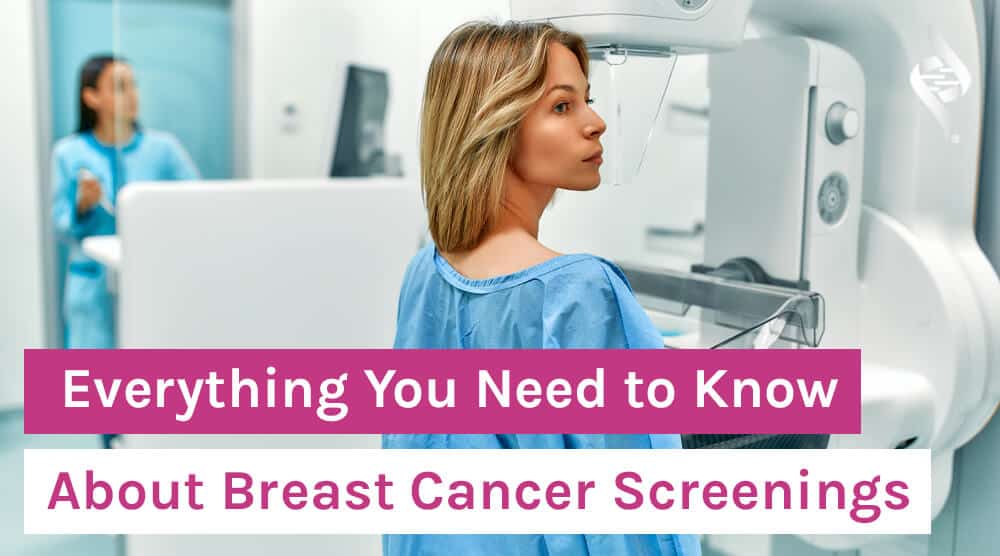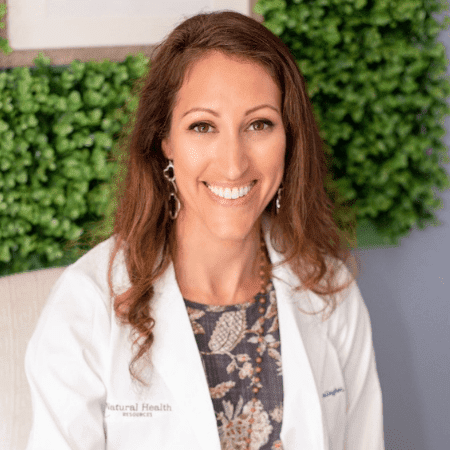Everything You Need to Know About Breast Cancer Screenings
Video Transcript:
Let’s talk about breast screenings, breast cancer screenings. This is a very common question we get from a lot of you viewers. And I am daily working with patients in assessing the assorted, noninvasive resources we have, and technology that we can tap into that can help us determine our course of action in breast cancer prevention, as well as addressing any suspect or abnormal cellular tissue that might reside in your breast cells.
Thermography
So, let’s talk a little bit about an amazing resource that we have that can often detect cellular and inflammatory-related changes eight to 10 years before we even see that show up on a mammogram or an ultrasound. And this technology is called thermography, or getting a thermogram. What thermography is is a reading, a thermal reading of your body. We concentrate in the breast zone to assess the breast health, but you can do a full body scan, you can do a scan of your thyroid.
All areas of the body can be targeted, but thermography specifically is going to be a situation where it is the least invasive, it is a very easy, simple resource where you often will have access to either a thermography center or many cases, like with my wellness center, we would have a thermography center come in, a specialist that would set up a little thermal imaging camera, so just like a digital camera, and then the room would be really cold and you would disrobe. And then the camera would do a scan and you get side view, you get back view, and it would assess the assorted changes and temperature and inflammation within that area or the full body.
What thermograms are, how they’re powerful is, one, the thermal imaging is going to be read by a radiologist. So, this is an expert that knows what they’re looking for in terms of tissue changes, inflammatory conditions, and we can also utilize thermography to identify if there are any, what we call hot cells. Maybe there’s a state of inflammation, a clustering of inflammation, a little dot of it.
We can also see assorted imbalances or lack of lymphatic flow throughout the body. And while thermography is not yet FDA-approved, it is my go-to and my recommendation for all screenings of any type of cancer, as well as the screening to be able to determine the state of inflammation within your body. If you do a full screen, you can also identify any inflammation related to dental work or up in your ears or down circulation flow and imbalances with your legs and lower extremities.
When to Get Screenings Performed
So, thermography is fantastic specifically at identifying base-level cellular changes and inflammation within the body. How thermography is performed, you get your first baseline scan, and then three months later, you do a repeat scan. So, we have an identification of exactly the state of your breast.
And this goes into kind of the detail about when to do screenings. But often, you want to have your screening – be it thermography, your ultrasound, or mammograms – you want to have your screening from day five of your cycle to day 10. So, if your period is day one, for women who are menstruating, go in day five to day 10, that is when you’re going to have the most supple, least fibrotic or denser breast tissue. So, repeat those screenings in that timeframe, so we get a better accurate version of your breast cells.
So, thermography is great for that and you do a repeat on the third month and then you repeat every year. And that is how I choose to analyze my breast health as well as overall inflammatory state.
Ultrasound
Now, the second option is ultrasound. And there are an assortment of ultrasound options. There are 3D ultrasounds. There are ultrasounds that are going to be performed by a technologist or technician who is an ultrasound tech and they are manually performing ultrasound.
And now, one of the most effective ultrasound is what we call an automatic whole breast ultrasound, and it’s going to take over 3000 assorted images. And there’s a particular ultrasound machine called SonoCiné, and we’re starting to see the development of these SonoCiné machines. They’re in California, they’re in assorted middle… kind of the middle part of America and other areas in the northeast. So, you may or may not have one of these machines or access to this type of ultrasound, but it is coming and it is definitely what I recommend over traditional ultrasound or tech-involved ultrasound.
Basically, how it works is you wear this mesh kind of sports bra, and this ultrasound machine literally will take images of the top part of the breast, lower part of the breast, side, you get underneath the armpit, so you analyze your lymph nodes. It also gets right here in the middle part of the breast.
It is extremely comprehensive and one of the things that we’re seeing (this was developed by a breast specialist), one of the things that we’re seeing is that this type of automated whole breast ultrasound is so comprehensive, it is finding abnormal lesions or abnormal cells up to or as small as two to three millimeters. Often, those are going to be missed by traditional ultrasound that’s guided by a tech and kind of at the whim of the tech searching for something. Or as well, we see sometimes that being missed by mammograms.
So, the SonoCiné is definitely, in my book, one of the resources and recommendations I have for a lot of my patients that might have denser breast tissue. And it’s a great overall line of assessing suspect tissue or analyzing any areas of where you palpate any tenderness or feel cellular changes, density of your breast tissue.
Mammograms
Now, the last and final one that’s very common are mammograms, and there are assorted mammograms. There’s 3D or 2D mammograms. There’s the head-on kind of normal mammogram type. So, there are different ways of screening via mammography. And mammography has a place in our medical model. It’s the only, the primary, resource that we often see.
I’m now seeing a lot of OB-GYNs and breast surgeons recommending a combination of ultrasound and mammography because the two together can catch more than the two individually. So, just know that sometimes it might be the two in combination that you’re having, but ultimately, you are in control of your health and wellness and you’re also in control of the screenings.
Be Proactive & Advocate for Your Health
I’ve even had my own personal experience where I want just an ultrasound and some of the policies of imaging centers require I also have a mammogram. And so there’s just… you might have to call around, you might have to find one screening tech versus another that’s a little bit more open-minded.
But just know, you have ultimate power in terms of utilizing these resources as prevention, but also diagnostically to determine, do you necessarily need to have a biopsy? If you go with thermography, you get a SonoCiné, full breast automatic, automated whole breast ultrasound. If there’s nothing that is suspect in those, then it might not necessarily be a course of action to go get a biopsy.
So, just know that you have a lot of different options in your arsenal. Some might not be covered by insurance. Some you might have to travel to or go out of your town. But there are a lot of very powerful tools that we can tap into. And then you can work those into your screening resource, or your screening plan. Whereas, maybe my screening plan is a little bit less aggressive than others that maybe have family history.
So, just know these are some really great resources. If you haven’t tried thermography, it’s awesome. So, I definitely recommend you test that out and get a screen and see what comes from that.
So, I’m excited to share these tips with you. And just know, it is very important that we be proactive. Screenings do not have to be fear-oriented. They’re powerful as tools. It’s information, gives us knowledge. Knowledge is power. I hope that’s helpful for you.
Joint & Muscle Care is a revolutionary supplement that takes three of the strongest inflammation support agents in nature (frankincense, myrrh, and turmeric), and combines them in the same perfect union treasured by the ancients. Available in capsule form or as an essential oil blend called Magi-Complexx.






I am going to be 76 in November. Do I still need to screening for breasts ?
I heard that mammogram tends to cause a cancer (or, if you have even a tiny cancer cell, it will make it spread) and better not to have it.
Thank you.
Great information. Thank you. The only problem is that thermography and whole breast ultrasound are not easily accessible the way mammograms are. It’s a shame. Hopefully they will add these options to diagnostic centers.
Hi, Is there any place in New Jersey (Morris County) where I could go for a thermography? thank you for your help.
Hello Melissa, I have been doing thermography since my 1st diagnosis of stage 4 breast cancer. PETscan indicated NCD after treatment. I did thermography yearly. Then stage 4 breast cancer returned, 9 years later. THERMOGRAPHY did not detect it, I even paid to have another on my way to the oncologist. The really disappointing aspect is the various places I had gone for thermography are not interested in helping me understand why it did not detect in my situation. Suggestions/recommendations welcome
There is another non invasive screening method QT technology, I do not know much about it.
I’m curious what you think about breast MRIs? My doctor and imaging center suggest an MRI and not thermography or an ultrasound. I don’t want excessive radiation.